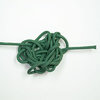birdus
Line Up and Wait
- Joined
- Aug 26, 2017
- Messages
- 606
- Display Name
Display name:
Jay Williams
What knot does everyone use for the ground end of the tie-down rope?
As far as the end of the rope that attaches to the wing, what do you all think of this? (only 1:39 long)
Follow-up: what should I use for the tail? I'm guessing a bowline (or one of the other good alternatives suggested in this thread) would work for the ground end, but what about what goes on my tail-wheel (probably hooked over the top of the spindle)? I'm thinking I'd want some kind of knot that I can tug on to get the line nice and taut so that I can add some tension on the lines I've used to tie the wings down.
As far as the end of the rope that attaches to the wing, what do you all think of this? (only 1:39 long)
Follow-up: what should I use for the tail? I'm guessing a bowline (or one of the other good alternatives suggested in this thread) would work for the ground end, but what about what goes on my tail-wheel (probably hooked over the top of the spindle)? I'm thinking I'd want some kind of knot that I can tug on to get the line nice and taut so that I can add some tension on the lines I've used to tie the wings down.
Last edited:


